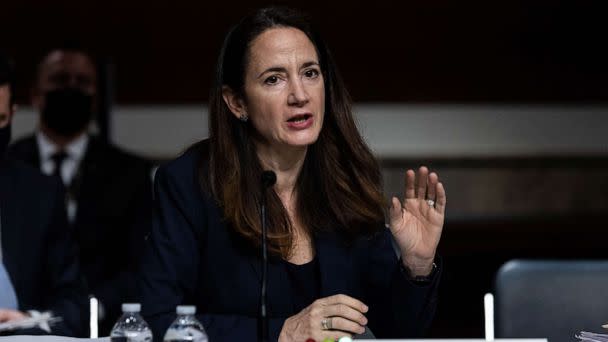Russian President Vladimir Putin is preparing for a “prolonged conflict” in Ukraine, and could resort to drastic measures if the fighting doesn’t go his way, according to Director of National Intelligence Avril Haines.
During a Senate Armed Services Committee hearing Tuesday, Haines said Putin’s invasion of Ukraine has sent a shock through the geopolitical order, “with implications for the future that we are only beginning to understand, but are sure to be consequential.”
Though Putin has focused his forces on Donbas after failing in the north, THE U.S. does not believe he will be content with the eastern part of the country, Haines said.
“The next month or two of fighting will be significant as the Russians attempt to reinvigorate their efforts. But even if they are successful, we are not confident that the fight in the Donbas will effectively end the war,” she said. “We assess President Putin is preparing for prolonged conflict in Ukraine during which he still intends to achieve goals beyond the Donbas.”
But for now Putin’s goal is to take control of the Donetsk and Luhansk oblasts in Donbas and encircle Ukrainian forces from the north and south “in order to crush the most capable and well-equipped Ukrainian forces who are fighting to hold the line in the East,” Haines said.


MORE: Russia-Ukraine live updates: Russia is running out of missiles
Putin would also like to “consolidate control of the land bridge Russia has established from Crimea to the Donbas, occupy Kherson, and control the water source for Crimea,” she said.
The U.S. also sees signs his military wants to extend that land bridge to Transnistria, in Moldova, according to Haines.
Haines said Russia might be capable of achieving “most” of those goals in the coming months, but would need to mobilize more troops to achieve the last:
“We believe that they will not be able to extend control over a land bridge that stretches to Transnistria and includes Odessa without launching some form of mobilization. And it is increasingly unlikely that they will be able to establish control over both oblasts and the buffer zone they desire in the coming weeks,” Haines said.


MORE: Biden signs bill to expedite shipments of weapons, supplies to Ukraine
But Putin is “probably counting on U.S. and EU resolve to weaken as food shortages, inflation, energy prices get worse,” she added.
Economic forces are at work in Russia as well, with sanctions from the West having a “pretty significant” impact on Russia, according to Haines.
“Among the indicators that one might look at are, for example, the fact that … we predict approximately 20% inflation in Russia, that we expect that their GDP will fall about 10%, possibly even more, over the course of the year,” she said.
The fighting itself has also worn on Russia’s capabilities.
“Our view is that the ground combat forces have been degraded considerably. It’s going to take them years … to rebuild that,” she said.
But degraded conventual forces could drive Putin to other means of exerting force.
“That may end up meaning that they have greater reliance in effect on asymmetric tools during this period,” Haines said. “So they may rely more on things like cyber, nuclear, precision, etc. And that’s obviously a shift in the way in which they are exercising their efforts for influence.”
The discrepancy between Putin’s high aspirations and his degraded conventional capability could lead to “a more unpredictable and potentially escalatory trajectory,” and “a period of more ad-hoc decision making in Russia” in the next few months, Haines said.
This could also manifest itself domestically.
“The current trend increases the likelihood that President Putin will turn to more drastic means, including imposing martial law, reorienting industrial production, or potentially escalatory military actions to free up the resources needed to achieve his objectives as the conflict drags on, or if he perceives Russia is losing in Ukraine,” she said.
What could happen next?
“The most likely flashpoints for escalation in the coming weeks are around increasing Russian attempts to interdict Western security assistance, retaliation for Western economic sanctions or threats to the regime at home. We believe that Moscow continues to use nuclear rhetoric to deter the United States and the West from increasing lethal aid to Ukraine and to respond to public comments of the U.S. and NATO allies that suggest expanded Western goals in the conflict,” she said.
The next step for Putin could be to launch major nuclear drills to command respect from the U.S.
“If Putin perceives that the United States is ignoring his threats, he may try to signal to Washington the heightened danger of its support to Ukraine by authorizing another large nuclear exercise involving a major dispersal of mobile intercontinental missiles, heavy bombers, strategic submarines,” Haines said.
But so far U.S. officials have said they do not believe Russia is preparing to actually use nuclear weapons in Ukraine or elsewhere.
“We otherwise continue to believe that President Putin would probably only authorize the use of nuclear weapons if he perceived an existential threat to the Russian state or regime,” Haines said.
Putin prepping ‘prolonged conflict’ beyond Donbas, could escalate nuclear threats: Top US intel official originally appeared on abcnews.go.com




